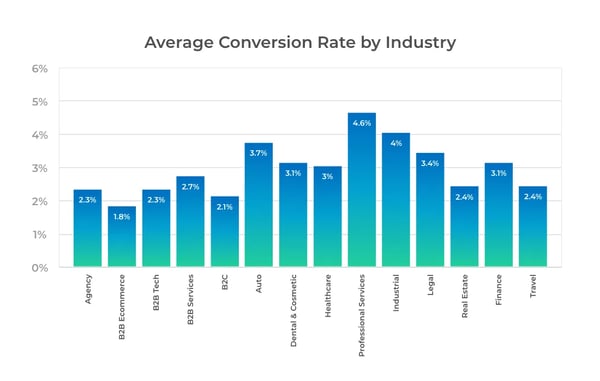Why Conversion Rate Optimisation is your Best Ally
CRO or Conversion Rate Optimisation is the practice of increasing conversion rate (conversion rate means the number of conversions achieved from a website's visitors over a specified period of time), by optimising web pages to more efficiently convert the visitors who land there. Essentially, pushing more of the people who land on your website towards becoming a customer. It is a broad based skill that requires excellence in a range of disciplines including copywriting, design, UX (User Experience), as well as testing and data analysis.
Conversions range from online purchases to form fills, sign ups, gated content downloads or any number of other targeted actions. So, effective Conversion Rate Optimisation optimises web pages to monitor these conversion tracking events, increase how frequently they occur, drive more conversions, encourage visitors to become customers and ultimately deliver revenue for your business.
The reason that Conversion Rate Optimisation is so important is simple. Delivering visitors to a website can be a time and cost intensive process. Failing to adequately optimise the conversion process on that website is effectively throwing that hard won traffic, and investment, away. Great Conversion Rate Optimisation does not just boost conversions, it can also work to filter your traffic, leading poor fit traffic to leave the site, freeing your sales resource to focus on the traffic that will deliver the greatest revenue and benefit to the business. Good Conversion Rate Optimisation is essential in delivering maximised returns from investment across your website and in paid and organic search.

Conversion Rate – A Pivotal KPI for Marketers
In broad terms, a website’s success boils down to how easily it is found by the relevant audiences, (visibility) and how well it converts them into customers once they land there, (conversion).
Visibility is determined by how well the website attracts and serves its target audience, while conversions are reliant upon both a good level of the right traffic and delivering what that traffic is looking for, in a user friendly, accessible, and compelling way. Attracting the right traffic to the site is a vital first step, but the value of that traffic is lost if the site cannot convert it effectively.
That is why conversion rate is such a critical metric for marketers. It tells them how well their website is performing against its primary purpose.
Calculate Conversion Rate
Conversion rate is typically calculated with this conversion rate formula:
number of conversions over time
________________________________________________________________________
number of sessions (or users if preferred) over time
Progress is measured by comparing year-on-year, month on month or on specific periods following tranches of Conversion Rate Optimisation work, typically this data will be tracked and measured in Google Analytics. You can calculate conversion rate across your website by section, using this conversion rate formula, by vertical or by whatever grouping suits your business model best.

Improving Conversion Rate as a Strategy
Conversion Rate Optimisation can enhance revenue results without the need to drive greater quantities of traffic to your website, which can be costly or difficult to achieve in a competitive marketplace. Improving conversion rate also improves the value of every channel that delivers traffic to your website, increasing conversions that not only build revenue but drive brand awareness, and potentially referrals, within your target market too.
If you double conversion rate when your traffic stays the same, you’ve doubled your conversions without having to invest in traffic acquisition!
However, despite the need for clear data and analysis in Conversion Rate Optimisation, it is essential to approach it holistically, with a more human point of view too. Consider the performance of your website in terms of the people you want to attract, retain, and convert. What drives them, what turns them off, what interests them and what hooks them into converting. Understanding your audience behaviours, their needs and wants, are all key in shaping a truly effective Conversion Rate Optimisation strategy.
Conversion Rate Optimisation – Iterative or One-Off?
Conversion Rate Optimisation is not a one time thing, nor is it something you can do sporadically and still achieve optimum results. Great Conversion Rate Optimisation is ongoing, consistent, and iterative. Measuring conversion rate, benchmarking it and monitoring it are crucial ongoing activities. After all, markets change, competitors improve their own sites, consumer habits change, and every change or fluctuation in the competitive market will impact and change the relevant best practice for delivering the right User Experience (UX) and, as a result, the right Conversion Rate Optimisation activities for your website.

Target Audiences and Personas
While arguably, Amazon keeps leading the way in best practice for ecommerce by setting a very high bar, Gen Z don’t shop in the same way as millennials or boomers do. So, as your customer base changes or ages, their habits change too, and it is essential to fully understand your target audiences if you are to effectively engage with and convert them on your website.
Establishing clear, detailed personas for your target audiences ensures that marketers are able to plan the right content, the right calls to action, the right customer journeys and the right resources and tools to engage with and meet the needs of the people they want to convert. The purpose of developing personas is essentially to step into your customers’ shoes and answer the question ‘What is the job to be done or the need to be met?’ then prepare and deliver the ideal solution, using the right tools, for the right price, at the right time.
Finding the Right Conversion Rate Optimisation Strategy for Your Business
Conversion Rate Best Practice
There are no cookie cutter best practices in developing the right User Experience on your website, every market and every audience responds differently to different strategies. It’s an iterative test and measure process to determine what works right now for each of your audiences, because what worked last year, may not still work as well next year. Testing, measurement, and data analysis are key. Find what works, test it, use it, evolve it, and repeat. It also never hurts to understand what appears to work well for your competitors either.
It’s worth remembering here that conversions can relate to any number of actions and will be specific to your business and your objectives. Some conversions will be macro (significant) and others will be micro (smaller steps along the customer journey). Conversions to consider might include anything from an online sale to a demo request, signing up to a newsletter, filling in a gated content access form, conversing with a chat bot or even viewing a video.

How to Improve Conversion Rate
Effective Conversion Rate Optimisation starts with User Experience. We’ve put together the list below to summarise a few of the key areas to consider as part of an effective Conversion Rate Optimisation strategy. Each business will benefit from a different Conversion Rate Optimisation strategy, tailored to their industry, audience(s), products and services, and objectives. However, the list below is a great place to start when considering how best to make your website a more effective conversion tool.
Conversion Rate Improvement Checklist
- Careful selection of marketing channels – research and select the right channels and media to engage with your audience.
- Targeting – when bringing traffic from external sources (PPC, social, organic), ensure you’re targeting the right audiences through keywords, messaging, location/demographics.
- Iterate your landing page experience – by evolving landing pages specific to campaigns or keywords, you will improve your visitor’s experience and deliver them a solution that is more specific to their needs, building engagement and increasing the likelihood of conversion.
- On-Page Optimisation - Optimise high (and low) performing pages on your website in line with your keyword strategy to attract and retain the right visitors on the right pages of the site.
- Specific Calls to Action (CTAs) – Include CTAs on each relevant page of the website, including blogs – tailored to the content on the page, their purpose is to indicate the next step, deepen engagement and to prevent the visitor from bouncing off your website.
- Social proof – provide proof that you’re the right business to buy form (testimonials, case studies, reviews/ratings, awards).
- Story telling – make sure you’re telling a story that resonates with the audience. Always focus on what matters to them so start with benefits, advantages, and keep features til last – always think about the audience pain points rather than focusing on your product/service first.
- Navigation – ensure the visitor can easily access the areas of your site that will help them make a decision – product/category pages, service pages, about, contact/demo, blog/resources, pricing. Everything should be logical, easy to find and available in one or two clicks.
- Defined user journeys – Research and develop the user journeys your target customers take through the website, based on data and feedback, to improve their experience, satisfaction and the rate at which they subsequently convert. page by page conversion rate will allow you to analyse and replicate the effect of high performing pages across your website.
- UX (User Experience) - Find the right balance between design and information. Your website design should enable your visitor to get the information they need easily, not just look beautiful (remember beauty is subjective, the site needs to please your audience, not you!). It is more important to have enough text to provide the information the visitor, and search engines, need. Test and use different content formats to provide what’s needed to your different types of audience, this might include text, video, audio, imagery, and graphics.
- Speed – check that your website is easy to use, fast to load, and works! Visitors won’t wait and will quickly move on to a different website if yours doesn’t respond quickly enough. A drop in conversion rate on specific pages/areas of your site can indicate something is wrong so stay alert.
- Technology – Leverage the right technology, for example HubSpot, to automate nurture in the form of workflows etc to maintain contact and build engagement.
- Conversational Marketing - Implement conversational marketing tools that engage with and direct visitors to the information they need, quickly and efficiently, without requiring human input.

How To Test Your Conversion Rate Optimisation Strategy
Once you have fully researched your audience personas and developed a data-led Conversion Rate Optimisation strategy designed to engage with them directly, it is time to test your theories. Testing is essential, it allows you to identify and remove elements that don’t work as well as finding those that do and leveraging them fully.
Here are a few of the ways you can test parts of your Conversion Rate Optimisation strategy to tailor it more closely to your audience(s) needs across the different areas of your website.
- Ensure you don’t test too many things at once or you won’t know what caused the change. Also avoid changing anything while the test is running.
- Record benchmarks & agree on metrics you’ll use to determine success/failure.
- Ensure tracking is properly implemented.
- Allow enough time to gather data before making a decision, so it’s statistically significant and accurate.
- Pick pages with enough traffic volume to deliver realistic results or your tests won’t be conclusive. Each section of your website will have its own page conversion rate.
- Correlation isn’t causation: ensure you understand the cause rather than assuming it.
- Keep iterating – don’t run a test once and never do it again – results might change as consumer behaviour changes (just because your tool/design/video isn’t attracting people now, doesn’t mean it will never do).
- Test things that are significant first (changing the colour of a button probably won’t make a massive difference whereas adding a button somewhere that needs it, might).
Testing Your Conversion Rate Optimisation Changes
You can test changes to your pages with A/B or multi-variant testing. However, if your CMS does not allow that functionality, you can try testing a theory on a few key pages first, then roll it out to other pages if the data confirms it is an effective change.
What Is a Good Conversion Rate?
This will be different for every industry and every business. After all, each business also has its own model and strategy combination. However, you can establish a baseline by benchmarking online, though it is important to maintain these benchmarks as they will fluctuate over time.

(Image created from https://www.ruleranalytics.com/blog/insight/conversion-rate-by-industry/)
Measure conversion rate against the relevant benchmarks, you can track the validity of your Conversion Rate Optimisation efforts. It is worth noting that it is likely that your progress will slow over time as you improve and typically you will reach a ceiling rate eventually.
Benchmarking For Better Conversion Rate Optimisation
For more detailed analysis, you should track and benchmark by channel too, as each channel has a different benchmark rate to consider. For example, paid display advertising and social media usually have much lower conversion rates than organic search or email. This is because of the targeting that is possible with organic search and email marketing that is not so available with display and social media.
How To Start Improving Your Website Conversion Rate
Building an enviable conversation rate requires experience with a number of skills as we’ve outlined above. However, the basis of great Conversion Rate Optimisation is rooted firmly in common sense and in understanding how people think and act. Close familiarity with your true target audiences is essential, and from there, it is a case of theorising, testing, measuring, and iterating. It’s important that you treat this as a constant process though to ensure your business rides the waves on change in your industry successfully.
Our team of digital marketing experts are skilled at developing, and implementing, effective Conversion Rate Optimisation strategies for our clients. We work closely with our client companies as part of their team to fully understand how they work and who they serve. Our strategic Conversion Rate Optimisation planning is evolved and tested over time, using solid data and deep experience to optimise conversion rate and drive exceptional ROI.
If you’d like to talk to us about effective Conversion Rate Optimisation for your business then we’d be delighted to talk to you about it, why not get in touch here and start a conversation?
With ample potential and benefits to your brand, incorporating video into your full digital marketing strategy is pivotal for continued business success and growth over time. We understand that being heard above the digital noise online is challenging – but we can help. Get in touch with Innovation Visual and explore our diverse range of video services and how you can leverage them for your business.







